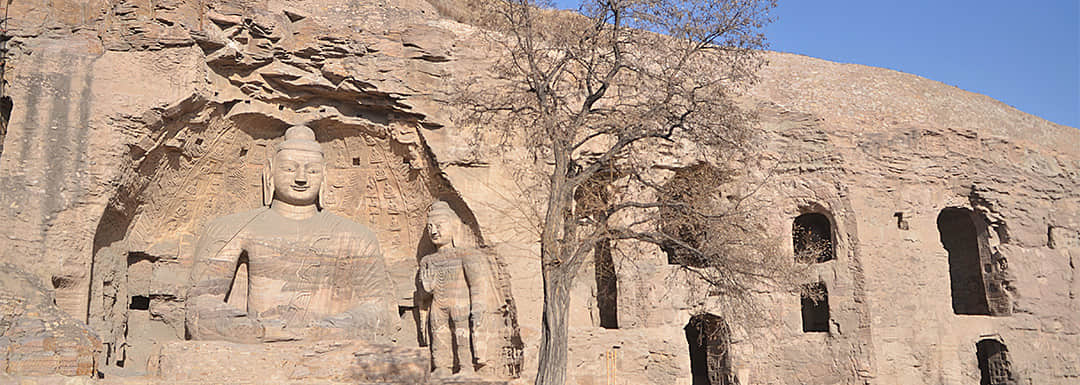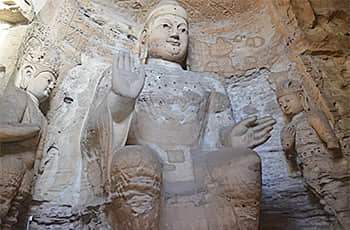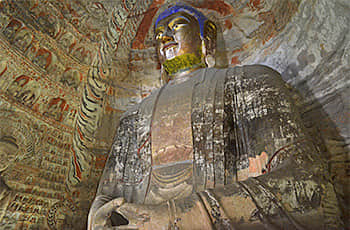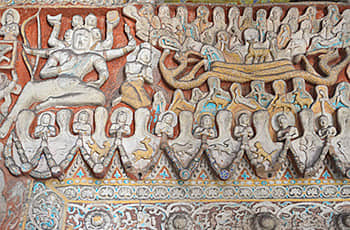Yungang Grottoes

The Yungang Grottoes are located at the southern foot of Wuzhou Mountain, 17 km west of Datong, Shanxi Province, northern China. The grottoes are carved into the mountains and stretch for 1 km. There are 45 main caves, 252 large and small shrine caves, and more than 51,000 stone statues. It is one of the largest ancient cave groups in China. Along with Dunhuang Mogao Grottoes, Luoyang Longmen Grottoes and Tianshui Maiji Mountain Grottoes, they are the top four grottoes in China.
- Chinese name: 云冈石窟 yún gāng shí kū
- Suggest time: 2- 3 hours
- Ticket: RMB 120 per person
- Open hours: 8:30-17:30 from April 1 to October15; 8:30-17:00 from October16 to March 31
- Best time to visit: all year around
- Address: Datong, Shanxi Province
- How to get there:
1. Take Express Travel Bus 603 from Datong Train Station to the site directly
2. Take Public Bus No. 4, 17 or 28 from Datong Train Station, Long Distance Bus Station to Xinkaili Station and then transfer to Bus No. 3 to the scenic area
Highlights of Yungang Grottoes 

The imagery of Yungang Grottoes is magnificent and rich in content. It is the crown of Chinese stone carving art in the 5th century. It is known as the bank of ancient Chinese carving art. According to the time of excavation, it can be divided into three periods: early, middle and late phases. The grotto statue style also has its own characteristics. The early Tanyao Grottoes were magnificent, with a simple touch of western-style sentiment. The middle phase grottoes are famous for their fine carvings and decorative adornments. They show the complex and varied Northern Art style from the North Wei Dynasty. Although the late-phase caverns are smaller, the characters are slim and beautiful and the proportion is moderate. It is the model for the art of grottoes in northern China and the source of the "slim bones".
Introduction to the grottoes (excerpt)
Cave 1 and Cave 2

These two caves are located in the east end of Yungang Grottoes. In the center of Cave 1, two square columns are carved. The statue behind the rear wall is Maitreya. Buddha statues in the four walls are mostly weathered and denuded. Vimo and Manjusri are caved in the sides of the south wall. The Buddha's life story relief in the lower part of the east wall is better preserved. The center of Cave 2 is a square three-story tower. Each floor is engraved with three attic shrines. The inner wall of the cave is also carved with five-layer towers.
Cave 3
This is the largest cave here. The front wall is about 25 meters high. It is said to be the sutra translation for Tan Yao. For the front chamber, a Maitreya cave is made in the middle of its upper part. Three-layer towers are chiseled from both sides of the front chamber. On the west side of the south of the rear chamber, three statues with rounded faces, good muscles, fine chaplets and smooth lines are sitting there. The middle Buddha sits about 10 meters high and the two Buddha statues are 6.2 meters high.

Cave 5 and Cave 6
These are double grottoes. The fifth cave is located in the middle of the Yungang Grottoes. The cave is divided into the front and rear rooms. The main image in the rear room is the Three Generation Buddhas. The central one sits 17 meters high. That is the largest Buddha statue in the Yungang Grottoes. Shrines and statues are all in the walls of the grotto. On both sides of the arch, there are two Buddhas sitting on the top of the Bodhi tree with embossed flying sky and beautiful lines.
Cave 6 almost has a perfect rectangular shape. The two-layer square tower that reaches the ceiling is in the center. It is 15 meters high. Below the tower column, there is the big shrine. A sitting Buddha statue is in the south side, a Buddha statue leans against the west side, the north side is carved with Ying Duobao's sitting image, and the east side is carved with the Maitreya crossing his bare feet. On the four sides of the shrines for the tower pillar, the eastern, southern and western walls and both sides of the window, 33 pieces of Buddha-relief that depict Sakyamuni from birth to enlightenment are carved. This cave is magnificent, rich in carvings and refined in technique. It is the most representative one in Yungang Grottoes.

Cave 7
There are three layers of wooden eaves in front of the cave. The grotto is divided into two chambers. The upper part of the rear room wall is engraved with a bodhisattva sitting on a lion. On the east, west and south sides, many Buddha statues and shrines are engraved. Six bodhisattvas that sit on the south wall arches are beautiful and realistic. When you see the embossed Feitian (flying fairies with long silk clothing in the wind) at the top of the cave, it seems that the figures dance beautifully.
Cave 16 to 20 Early Grottoes
These five caves are also known as Tan Yao Cave as they were built by the famous monk Tan Yao. The main statues inside the caves are Buddhas of the past, the present, and the future. The Buddha statues are very tall, with big, round faces, high noses and deep-set eyes, and big shoulders. This represents the highest level carving skills, which was inherited from the Han Dynasty. Mixing that talent with the art essence of ancient India (Gandhara) and Mathura, created a unique artistic style.
Drop us a line and we'll connect you with the top China expert in no time!